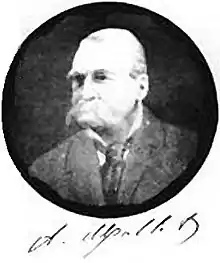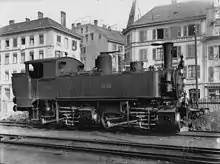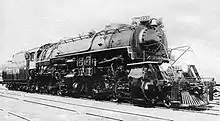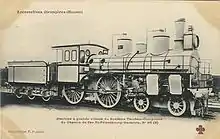Anatole Mallet
Jules T. Anatole Mallet (23 May 1837 – 10 October 1919) was a Swiss mechanical engineer, who was the inventor of the first successful compound system for a railway steam locomotive, patented in 1874.[1]

He is known for having invented three important forms of compound locomotive.

In 1876 he introduced a series of small two-cylinder compound 0-4-2T tank locomotives for the Bayonne-Anglet-Biarritz Railway in France.[2]


He subsequently designed an articulated compound system with a rigid chassis at the rear carrying two high-pressure cylinders, and two low-pressure ones mounted on a swivelling front truck. This was patented in 1884[1] with full rights granted in 1885.[3] This was first used for a series of 600 mm (1 ft 11 5⁄8 in) narrow gauge locomotives specially built by the Decauville Company in 1888 for the Paris Exposition of 1889.[3] This arrangement became known as the Mallet locomotive. The final developments of these in the USA were some of the largest steam locomotives ever built.

A third compound locomotive, less well-known, was a tandem compound developed in 1890 for SACM as a collaboration with Alfred de Glehn and the Russian A. Borodine.[4] The high and low pressure cylinders were mounted on a common axis, with the high pressure ahead. Unlike the US tandem compounds, the high and low pressure cylinders were cross-connected between sides, which also required them to be receiver compounds with an intermediate reservoir as a pair of curved pipes passing through the smokebox. Large numbers of these, mostly a 2-8-0 derivative, were built for Russian and Hungarian railways making them the most-produced type of tandem compound locomotive. Z. Kordina's design for Hungarian State Railways was a similar 4-4-0, although outside-framed and with the low-pressure cylinders ahead of the high pressure.[4]
He was awarded the Elliott Cresson Medal of The Franklin Institute in 1908.
See also
References
| Wikimedia Commons has media related to Anatole Mallet. |
- Ransome-Wallis, P. (1959). Illustrated Encyclopedia of World Railway Locomotives (2001 republication ed.). Dover Publications, Inc. pp. 500–501. ISBN 0-486-41247-4.
- Van Riemsdijk, Compound Locomotives, pp. 10–11.
- Durrant, A. E. (1974). The Mallet Locomotive. Newton Abbot: David & Charles. ISBN 0-7153-5904-5.
- Van Riemsdijk, Compound Locomotives, pp. 37–38.
- Van Riemsdijk, J.T. (1994). Compound Locomotives: An International Survey. Penryn: Atlantic Transport Publishers. ISBN 0-906899-61-3.